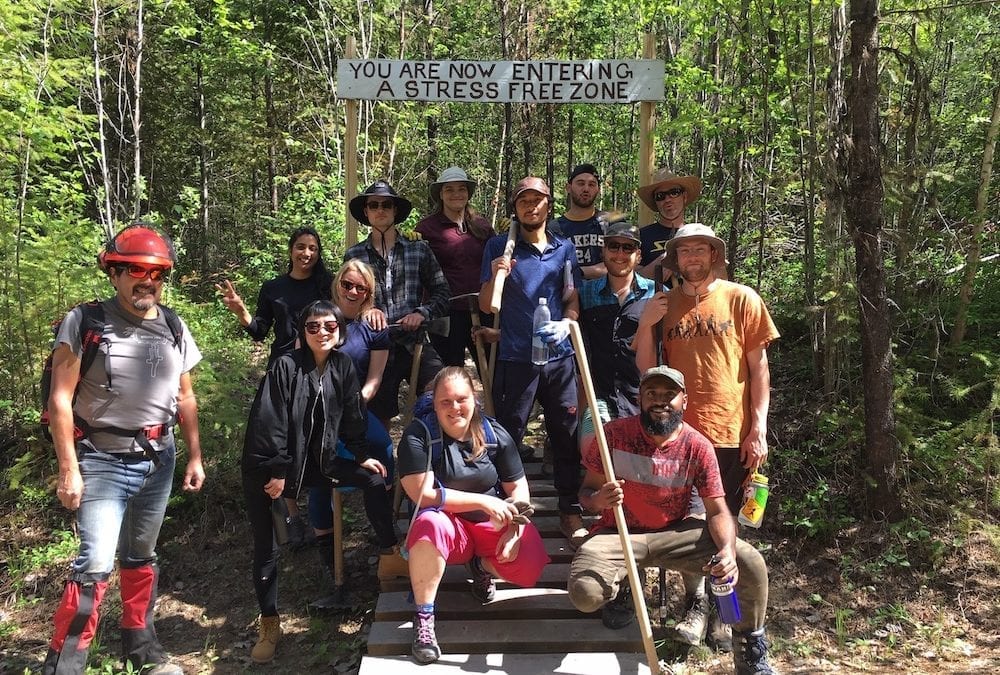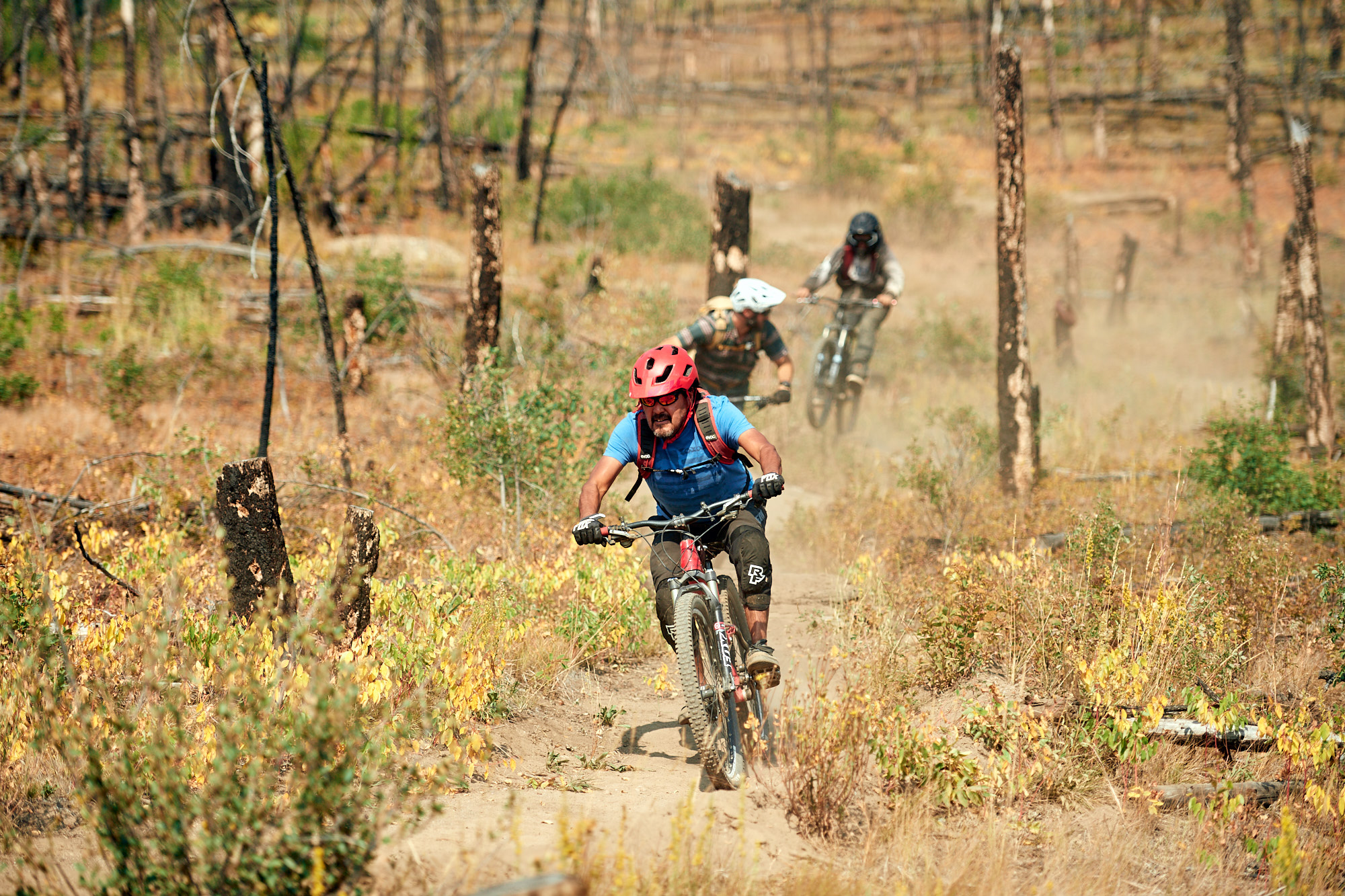How do we decolonize our mountain bike trails?
Singletrack through the woods can lead Indigenous and non-Indigenous riders toward moments of reconciliation, if the right connections are made.
 Photo by:
Craig Campbell
Photo by:
Craig Campbell
By Patrick Lucas
An elderly gentleman stood before a small group of people – men, women, youth and children – gathered around him in a semicircle. They were Simpcw, members of the Secwepemc Nation who have lived throughout the Interior Plateau of south-central British Columbia for more than 10,000 years. The elder raised his arms, hands turned inward to his face, arms gently pumping as though he was holding a delicate, sleeping child. Standing in a spruce and hemlock forest on a hillside overlooking the North Thompson River, we were gathered to celebrate the completion of a new singletrack mountain bike trail, hand-built by the youth.
“All my relations,” the elder spoke gently into his hands. We mirrored his actions and repeated his words together as a chorus. I’ve heard the phrase hundreds of times, invoked at the end of a prayer or blessing. It has always left me feeling awkward and out of place, an intruder on a cultural ceremony that was not my own. I would drop my hands and stay silent.
Standing next to me was my friend Tom Eustache, a member of the Simpcw First Nation, a fellow rider and a trail builder. It was Tom who invited my friend Thomas Schoen and me to the ceremony. As the founders of the Indigenous Youth Mountain Bike Program, we have worked with First Nations on trail projects throughout the province. For the three of us, standing together in the woods on a crisp autumn afternoon in the fall of 2019, the ceremony represented the culmination of five years of work to make Tom and the Simpcw Nation’s vision of using trails and mountain biking to assert their rights and title to their lands and territories a reality. For Thomas and me, the trail was a powerful symbol of how we, as settler Canadians, can support reconciliation and play a role in decolonizing trails and the mountain bike community.
“Decolonizing trails? What does that even mean?” Tom would ask me when I spoke of such things. I never had an answer.

Where recreation meets reconciliation
Trails and recreation are not free from the culture and politics in which they are built and used. They cannot be separated from our history. We may just be going for a ride, but every time we step out on the land, we are participating in an explicit political act upon a foundation of colonialism and genocide.
Reconciliation and decolonization have become increasingly meaningless to both Indigenous and non-Indigenous Canadians alike. The words have been bandied about as commercial and governmental organizations have forced pipelines through ancestral lands, such as Trans Mountain, and resorted to armed suppression in places like Oka and Ipperwash. They can be fancy words on the placards of protestors in downtown Vancouver that provide little of substance for communities in rural areas trying to create sustainable jobs and economic prosperity.
For Tom and the Simpcw people, colonialism is not an abstract concept or something relegated to the past. “Our people have always lived throughout the entire valley,” he explained to me, referring to the North Thompson. The government took away their land and confined them to an area that was a mere fraction of the massive territory that had been theirs for thousands of years. The trails we built together were a part of their ongoing work to reconnect with their territories and reassert their role as the caretakers and stewards of their lands.
“It’s all about relations,” Tom explained. “Our youth are learning what it means to reconnect, to foster a relationship with the land. They are building these trails and digging us out from the colonial system that stole our way of life.”
Indigenous Youth Mountain Bike Program and the Simpcw Trail Crew
Thomas and I had started the Indigenous Youth Mountain Bike Program in 2013 following the rise of the Idle No More movement that swept across the country in 2012 in the form of protests, blockades and flash mobs that pushed Indigenous rights and land claims into the national spotlight. That movement forced Canadians to start asking ourselves tough questions about our country, our history and to consider new possibilities for reconciliation. It was overwhelming. Thomas and I both felt helpless, unsure as to what we could possibly do. We turned to the only thing that’s ever made any sense in our own lives: bikes and trails.
During that same time, Tom Eustache started mountain biking, inspired to get his own children outdoors. With his son and nephew, they began cutting new trails in the forests above their reserve in Chu Chua, B.C.
Thomas and I were visiting First Nations throughout the province, attempting to sell our vision for creating an Indigenous mountain bike Shangri-La, where people would come together in the spirit of reconciliation and epic rides, when we stumbled into Chu Chua. We understood immediately there was something different about this small community tucked between the North Thompson River and the Monashee Mountains. The trails were little more than dirt lines scratched into the rocky forest floor with sketchy jumps built out of wood pallets and janky berms of dirt piled on rotting logs. Tom’s energy and enthusiasm were captivating. “When we’re not riding, we’re building,” he told us.
Thomas and I committed to supporting Tom and the Simpcw people in their vision for using trails to reconnect his people to their ancestral lands. During the next three years, we built nearly 15 km of world-class routes.

T’Sou-ke, Squamish, and SORCA
Throughout B.C., mountain bike clubs have been confronted with the reality of First Nations asserting and gaining greater authority over their lands and territories. In the fall of 2013, the T’Sou-ke First Nation, a small Salish community located on the southwest coast of Vancouver Island, signed a pre-treaty settlement agreement for an area called Broom Hill. The hill, called Sacred Mountain by the T’Sou-ke people, was a place of deep cultural significance. It also happened to be a popular riding area. Around the time of the agreement, panic rippled through the riding community. What would happen to the trails? Would there still be riding? People continue to ride Sacred Mountain. The T’Sou-ke Nation maintains that any decisions they make for the area will focus on the needs and priorities of their people and the health of the land. For the mountain bike community, the development was a wake-up call. With treaty and land-claim negotiations proceeding throughout the province, we needed to recognize the reality of reconciliation and the resurgence of Indigenous title on the land.
The mountain bike community has continued to engage and find ways of moving forward. In Squamish, a world-class destination for riding, the Squamish Off-Road Cycling Association has worked diligently to build a relationship with the Squamish First Nation. In 2019, the provincial government announced that it was transferring several parcels of land back to the Nation, which included a substantial number of popular riding trails. Once again, there was a sense of deep concern over access within the recreation community. SORCA, however, understood the most important priority was to value its relationship with the Nation and support its members’ roles as the caretakers and stewards of the land. Jeffrey Norman, president of SORCA said, “We recognize that we live and ride on the lands of the Squamish Nation. We unequivocally support the Squamish Nation’s right to self-determinacy on its lands and are grateful to be able to share in the spirit and beauty of this place.” SORCA and the Squamish Nation continue to work together to form an agreement that will guide the use and development of trails on the lands that could become a model for the entire recreation sector.
Renewed momentum
Early in 2020, I watched eruptions across the country once again with protests and blockades in response to the RCMP assault on the Unist’ ot’en Camp of Wet’suwet’en Nation in northwestern B.C., and later actions by the Black Lives Matters movement in the United States. Again, many people were beginning to question the state of our country and our relations with Indigenous peoples with an openness to new possibilities for engaging with anti-racism and reconciliation.
Back in the clearing, overlooking Chu Chua and the North Thompson, I saw more clearly than ever before what reconciliation and decolonization can look like. As Tom said, it’s all about relations. For those of us who are non-Indigenous and asking ourselves what we can do, it is a far more intimate and personal question than we may have considered before. We must look to our relations: our relations with Indigenous peoples on whose lands we live and play. Have we engaged with them when planning and building trails? Have we sought after and attained their consent? Are we supporting and upholding their rights and title? Have we sat and listened to the elders? Absorbed their stories? Taken their youth out for a ride? Shared our love of trails?

Trail Weavers
The elder stepped forward to deliver his final blessing, raising his arms up. Everyone followed his lead. I raised my hands up along with them and spoke the words. All my relations. It’s an acknowledgment of everything that makes the trails and the riding possible. It is a gesture we take as a group to show we are all prepared to step up and share in carrying our responsibilities and obligations, to caring for the land and each other.
When the ceremony was finished, Tom, Thomas and I took the kids on a ride back down the hill. The Simpcw trail crew refer to themselves as trail weavers, following the pathways of their ancestors, the master artisans who weaved cedar bark into beautiful works of art that protected and sheltered their people for thousands of years. The youth weaved in and around me, whooping, hollering and laughing, our bikes dancing down the trail, the story we’ve created together vibrating up through my tires, into my frame and into my body.
We reached the end of the trail, the youth coming down off the hill, braking and skidding into the small gravel parking lot, sending up sprays of rocks and dust. They tumbled off their bikes laughing and shouting, trading high fives. Their parents and elders stood by watching, beaming with pride.
A few feet away, Tom sat on his bike next to the trailhead kiosk, watching. One of the young boys standing next to him, turned and looked up at the trail map with the nation’s logo prominently displayed along with words: Weyt-kp xwexweytep Simpcwúl’ecw – Welcome to Our Land. With a look of astonishment on his face, he turned to Tom. “That’s our language. Our people!” he gushed. You could feel the wonder and pride emanating from his slight, trembling frame. That is what reconciliation and decolonization look like.
This story originally appeared in the February & March 2021 issue of Canadian Cycling Magazine
